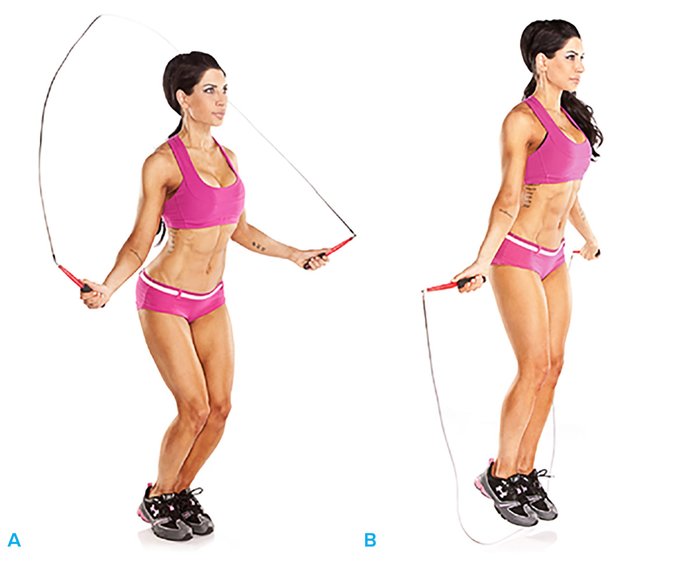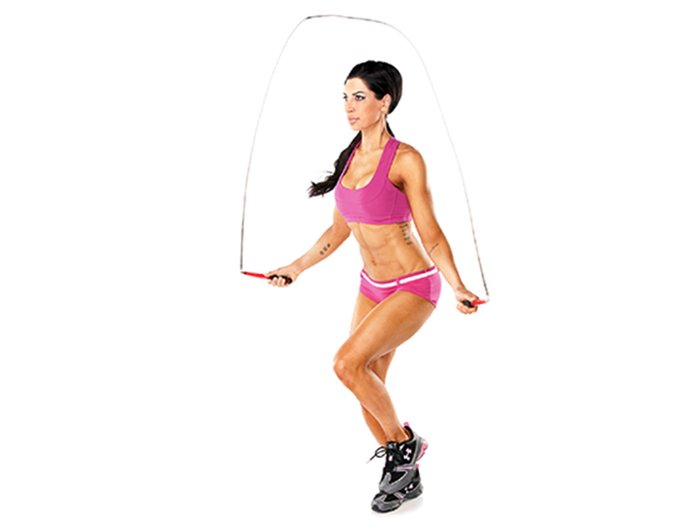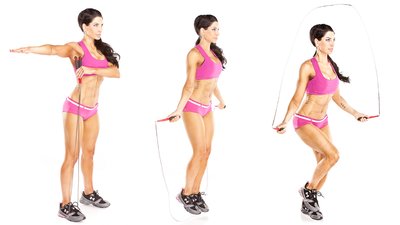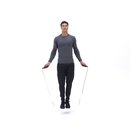Jumping rope? I know what some of you are thinking: That's for kids, or maybe for professional boxers like Floyd Mayweather, Jr., but it's not for me. I felt the same way all the way up to 2009. I loathed jumping rope, because I constantly tripped over the rope.
Still, I was far from fit—OK, I was overweight—and I knew that jumping rope was probably good for me. So I started searching around on the Internet, and it didn't take me long to discover Buddy Lee. He's a former Marine and former Olympic wrestler who spent the last 20 years spreading the gospel of jump-rope training. He teaches people how to do it properly. He's also a charismatic personality who can do mind-blowing things with a rope. Buddy convinced me to give the rope one more try.
This time around, something clicked with me right away. I had an epiphany! All of a sudden, I loved jumping rope. I threw myself into Buddy Lee's training system with an enthusiasm I'd never had for exercise before. Just a year later, I was personally trained and tested by Buddy Lee, and my status changed from "jump rope klutz" to "Certified Jump Rope Training Specialist"
Along the way, my physique transformed so dramatically that I began enrolling in fitness competitions. In 2011, just two years after I bought my rope, I earned my WBFF pro status and became a professional fitness model in 2011.
I owe my transformation to the jump rope. I'm here to show you how it can power yours.
Jump Ropes And The Busy Woman
I'm a busy dentist, personal trainer, and fitness model. I don't have time to go to a gym. It's even more challenging for busy career women who frequently travel for work and/or who have young children at home.
There are plenty of people who will tell you that your fitness level is directly tied to how much time you spend in the gym. As I travel deeper into the world of health and fitness, I have discovered the opposite to be true. Workouts don't need to be time-consuming or require expensive gym equipment to be effective.

Workouts don't need to be time-consuming or require expensive gym equipment to be effective.
Here's the bottom line: The only effective exercise regimen is the one you'll actually follow multiple times per week. In today's hectic world, this means it must be quick, fun, inexpensive, and portable. This is why I like to perform time-saving high-intensity resistance circuits.
Research shows circuits are the most effective way to boost the metabolism and burn fat. You can work smarter, not harder, by combining your strength training and cardio session into one short but intense muscle-building and fat-blasting workout.
A University of New South Wales study found that women who did anaerobic high-intensity interval training burned fat at a rate three times higher than those doing long-duration aerobic exercises.
I think you know where I'm going with this. When strapped for time, perform an all-in-one jump rope circuit!
Before You Jump In
Buddy Lee's Correct Jump Rope Form Checklist
- Maintain your balance by looking straight ahead.
- Maintain an upright posture.
- Maintain your weight on the balls of your feet.
- Jump only high enough to clear the rope (approx. 1 inch off the ground).
- Land lightly on the balls of your feet.
- Keep your elbows near your sides.
- Maintain your elbow joints at a 45-degree angle.
- When turning the rope, make 2-inch circles with your wrists.
- Do not sacrifice good form for speed.
You may be afraid that jumping rope will be hard on your knees. However, the truth is that when properly executed, jumping rope is actually a low-impact exercise.
By progressing gradually and jumping no more than 1/2 to 3/4 of an inch off the ground, you will cause less stress on the joints than jogging and actually strengthen your knee musculature.
In the long-term, the benefits of a consistent jumping program grow even larger. Aside from the obvious cardiovascular benefits, it increases bone density, minimizing your risk of developing osteoporosis. This is especially important for women, whose risk of osteoporosis in their 70s is double the occurrence among men.
This doesn't mean jumping rope is totally risk-free, but a little planning will go a long way to minimize the danger of injury. First off, wear cross-training shoes with sufficient forefoot padding to protect the balls of your feet.
Second, avoid jumping on hard surfaces such as concrete or tile. Instead, choose a surface that has give, such as wood, or one that will absorb impact, such as a rubberized surface.
Proper rope length is also crucial to your success. To determine your correct rope length, place one foot on the center of the rope and pull the handles up the sides of your body. If the handles extend beyond your shoulders, the rope is too long. It should be at armpit level.
As you become more proficient at jumping, shortening the rope will increase the rope's rotational speed and improve your reflexes. For best performance, cut the cord to the desired length, but if you don't wish to cut your rope to shorten it, you can tie a knot near the handle.
Bounce Step And Alternate Foot-Step
Before learning more advanced training techniques, it is imperative to first master the two basic jump-rope skills. Even before trying these, it is advisable to spend some time doing a "shadow jump." Shadow jumping is simulation of jump rope, only without the rope. Do not make the mistake of going from zero to hero, or you'll quickly get discouraged. It is crucial to follow a step-by-step progression with initial emphasis on technique rather than speed.

Bounce Step
At first, keep your focus on practicing timing and coordination. Start with one jump at a time. Once you master timing and rhythm, increase to five jumps per set. As you gain proficiency, keep adding jumps until you can perform 140 consecutive jumps. To build your proficiency, practice 5-10 minutes twice per day. Stretch after each session, especially your calves.
Over a six-week period, focus on gradually building your jump rope endurance from 140 to 500 consecutive jumps in small increments. Do not immediately focus on improving speed. Simply mastering these two techniques will provide you with a solid foundation for your jump rope training.
Bounce Step
- Jump with both feet approx. 1 inch off the floor.
- Land lightly on the balls of your feet.
- Do not let your heels touch the ground on landing.
- Master the bounce step before attempting the alternate-foot step.
Alternate Foot-Step
- Instead of jumping with both feet at once, alternate your feet as if running in place.
- Be sure to raise your knees to the front.
- Jump a little higher than 1 inch off the floor.
- Stay on the balls of your feet.

Alternate Fast-Foot
20-Minute High Intensity Resistance Circuit
Feeling confident with your rope? Let's take things to the next level by sandwiching jumping between strength exercises. I like to tackle an intense workout like this in the morning, because later in the day, it'll be too easy to talk myself out of it. Plus, this way I burn fat the rest of the day!
For this 20-minute circuit, set your timer for 50 seconds of work and 10 seconds of rest, for a total of 20 cycles. The goal is to transition between exercises with little to no rest time. I recommend you use a circuit timer like Gymboss, which can be downloaded onto your smartphone.
For the jump rope part of this circuit, use a combination of the basic bounce and alternate-foot step jump rope techniques. As you gain proficiency, increase the amount of jumps you can do during the 50-second work periods. In time, integrate the "high-step" technique, which is the same as the alternate-foot step technique except that you raise your knees to hip-level.

BodyFit
$6.99/month- 2,500+ expert-created single workouts
- 3,500+ how-to exercise videos
- Detailed workout instruction
- Step-by-step workout tips
- Training at gym or at home
- Access to Workout Plans
- Access to Bodyfit App
- Store Discounts
Already have a Bodybuilding.com account with BodyFit? Sign In

What comes with BodyFit?

- Instructional Videos
Don't risk doing a workout improperly! Avoid injury and keep your form in check with in-depth instructional videos.

- How-to Images
View our enormous library of workout photos and see exactly how each exercise should be done before you give it a shot.

- Step-by-Step Instructions
Quickly read through our step-by-step directions to ensure you're doing each workout correctly the first time, every time.
References
- Baker J.A. Comparison of rope skipping and jogging as methods of improving cardiovascular efficiency of college men. Research Quarterly, 1969, 39. P. 240-243
- Lee, Buddy. Jump Rope Training (2nd Edition). Human Kinetics. 2010.
- Lee, Buddy. Jump Rope Basics, Part 1: Preparation. CrossFit Journal, Issue 62, October 2007.
- Lee, Buddy. Jump Rope Basics, Part 2. CrossFit Journal, Issue 64, December 2007.




